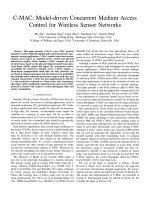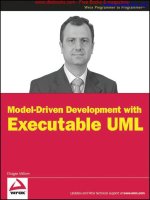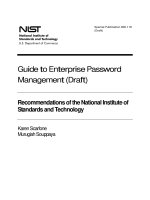model driven architecture applying mda to enterprise computing
Bạn đang xem bản rút gọn của tài liệu. Xem và tải ngay bản đầy đủ của tài liệu tại đây (2.5 MB, 354 trang )
Model Driven Architecture
Applying MDA to
Enterprise Computing
Model Driven
Architecture
Applying MDA to
Enterprise Computing
David S. Frankel
Publisher: Joe Wikert
Editor: Theresa Hudson
Assistant Development Editor: James H. Russell
Editorial Manager: Kathryn A. Malm
Associate Managing Editor: Angela Smith
Text Design & Composition: Wiley Composition Services
This book is printed on acid-free paper. ∞
Copyright © 2003 by David S. Frankel. All rights reserved.
Published by Wiley Publishing, Inc., Indianapolis, Indiana
Published simultaneously in Canada
No part of this publication may be reproduced, stored in a retrieval system, or transmitted
in any form or by any means, electronic, mechanical, photocopying, recording, scanning, or
otherwise, except as permitted under Section 107 or 108 of the 1976 United States Copyright
Act, without either the prior written permission of the Publisher, or authorization through
payment of the appropriate per-copy fee to the Copyright Clearance Center, Inc., 222 Rosewood Drive, Danvers, MA 01923, (978) 750-8400, fax (978) 750-4470. Requests to the Publisher for permission should be addressed to the Legal Department, Wiley Publishing, Inc.,
10475 Crosspoint Blvd., Indianapolis, IN 46256, (317) 572-3447, fax (317) 572-4447, E-mail:
Limit of Liability/Disclaimer of Warranty: While the publisher and author have used their
best efforts in preparing this book, they make no representations or warranties with respect
to the accuracy or completeness of the contents of this book and specifically disclaim any
implied warranties of merchantability or fitness for a particular purpose. No warranty may
be created or extended by sales representatives or written sales materials. The advice and
strategies contained herein may not be suitable for your situation. You should consult with
a professional where appropriate. Neither the publisher nor author shall be liable for any
loss of profit or any other commercial damages, including but not limited to special, incidental, consequential, or other damages.
For general information on our other products and services please contact our Customer
Care Department within the United States at (800) 762-2974, outside the United States at
(317) 572-3993 or fax (317) 572-4002.
Wiley also publishes its books in a variety of electronic formats. Some content that appears
in print may not be available in electronic books.
Trademarks: Catalysis is a service mark of ICON Computing. CORBA is a registered trademark of the Object Management Group. “Design by Contract” is a trademark of Interactive
Software Engineering. EJB, J2EE, and Java are trademarks of Sun Microsystems. Model
Driven Architecture, MDA, MOF, Unified Modeling Language, UML, IIOP, and XMI are
trademarks of the Object Management Group (OMG). MQSeries is a registered trademark
of International Business Machines. Visual Basic is a registered trademark of Microsoft
Corporation.
Library of Congress Cataloging-in-Publication Data:
ISBN: 0-471-31920-1
Printed in the United States of America
10 9 8 7 6 5 4 3 2 1
To my mother and my late father,
who taught me to value learning and truth.
To my wife Janice, my loving partner during
all the ups and downs of life.
To my children, Rafi and Ari, my connection to the future.
Contents
Preface
xv
Foreword
xix
Part One
Introducing MDA
1
Chapter 1
Pressure and Progress: How We Arrived at This Point
Challenges Facing the Software Industry
The Viability Variables
Machine-Centric Computing
Application-Centric Computing
3
3
4
5
6
From Assembly to 3GLs
Operating Systems and the Abstraction Gap
Object-Oriented Languages and Virtual Machines
Enterprise-Centric Computing
Component-Based Development
Design Patterns
Distributed Computing
Middleware: Raising the Platform Abstraction Level
Middleware: Raising the Programming Abstraction Level
Declarative Specification
Enterprise Architecture and Separation of Concerns
Enterprise Application Integration (EAI)
Design by Contract
Other Enterprise-Centric Technologies
Pressures on Enterprise-Centric Computing
Pressure on Production Costs
Pressure on Quality
Pressure on Longevity
A Modern Day Sisyphus
Summary
6
8
8
9
9
10
11
12
13
13
14
21
22
25
25
26
27
28
30
30
vii
viii
Contents
Chapter 2
Model Driven Enterprise Computing
Bringing Model-Centrism to Intermediate Tiers, EAI, and B2Bi
Models as Development Artifacts
Syntactic Abstraction versus Semantic Abstraction
B2Bi and MDA
First- and Second-Generation Web Services Integration
Web Services and Enterprise Architecture
Defining Abstract Business Services
Mapping Business Information Models to XML
Parameterized Mappings
Mapping Business Service Models to WSDL
Automating Business Processes and B2B Collaborations
31
31
32
32
35
36
38
39
41
41
42
43
Flexibility in Choosing the Abstraction Level
45
Modeling Language Extensibility
Platform Independence: A Relative Concept
46
48
EAI and MDA
The Limits of Declarative Specification
Metadata Integration
MDA and Component-Based Development
Automatic Pattern Replication
A J2EE Example
Architectural Styles
Pushing More below the Line
Model Driven Enterprise Architecture
Standardized MDA-Based Modeling Languages
Synchronizing among Multiple Tiers
Middleware and the Abstraction Gap
Design by Contract Revisited
MDA and Other New Development Approaches
Interactive Design
Extreme Programming
50
52
52
54
54
55
56
57
58
59
60
60
61
62
62
63
Summary
64
Part Two
The Base MDA Technologies
65
Chapter 3
The Role of UML in MDA
Origins and Evolution
Strengths
67
67
68
Separation of Abstract Syntax from Concrete Syntax
Extensibility
Support for Platform-Independent Modeling
Maintained by a Standards Organization
Weaknesses
Large and Poorly Partitioned
Weak Support for Viewpoints
Not Current with Industry Developments in Components
and Patterns
Vagueness about Relationships
68
70
71
72
73
73
74
74
74
Contents
Limitations of Profiling
Misalignment of UML and MOF
Lack of Standard Diagram Interchange
Lack of a Metamodel for Object Constraint Language
Future Directions
74
75
75
75
76
UML 2.0
Expected Outcomes
What You Can Do Now
Summary
Chapter 4
76
76
77
77
Beyond Basic Class Modeling
Design by Contract
79
79
The Basics
An Example
Contracts, Reuse, and Interoperability
As Precise as Programming3
Constraints and Exceptions
A Framework for Quality
DBC and UML Tools
Overcoming Barriers to Use
Another Look at Constraints
79
80
83
85
86
86
87
87
87
Behavioral Modeling
88
91
92
93
93
What You Can Do Now
Summary
Chapter 5
88
State Machines
Activity Models
Interaction Models
Use Case Models
Action Semantics
94
94
The Meta Object Facility (MOF)
A Key MDA Foundation
A Basic Premise
Borrowing from UML
MOF Isn’t Just for OO
Abstract Syntax Trees
Metalevels
95
95
97
98
101
103
105
Level M3
Level M2
Level M1
Level M0
How Meaningful Are Metalevels?
Self-Description
Metalevels and Abstract Syntax
105
106
106
107
107
108
109
Model Driven Metadata Management
110
What Is Metadata?
Volume and Value
Previous Attempts at Metadata Integration
110
111
111
ix
x
Contents
An Additional Premise
What Is the Benefit?
Platform Independence
Enforcing Semantics
Metadata Management Scenarios
Generic MOF Code
MOF Is Not CORBA-Based
Appearances versus Intent
Mapping beyond Syntax
Applying the MOF-CORBA Mapping
A Closer Look at XMI
Return on Investment
XMI and XML Schema
A Common Misconception about XMI
Hand-Coded DTDs and Schemas
XMI Complexity versus UML Complexity
XMI as Input to Generators
XMI and UML Diagram Interchange
A Closer Look at JMI
A MOF-Java Mapping
Aren’t XML and DOM Enough?
Another Look at MOF Self-Description
Additional Applications
Human Usable Textual Notations
XMI’s Reverse Mapping
Weaknesses
Lack of Coverage of Graphical Notation
Lack of Support for Versioning
Misalignment with UML
MOF-CORBA Mapping Problems
Interoperability Problems Due to Immaturity
Future Directions
Interoperability Testing
MOF 2.0
MOF in the Computer Industry
MOF and Enterprise Software
MOF and the Resource Description Framework (RDF)
112
113
113
115
115
118
119
120
120
120
122
122
124
124
124
125
126
127
128
128
129
131
135
135
136
138
138
138
139
139
139
140
140
140
140
141
142
What You Can Do Now
Summary
Chapter 6
142
143
Extending and Creating Modeling Languages
Extending UML via Profiles
145
145
A Family of Languages
Stereotypes
Tagged Values of Stereotypes
Standalone Tagged Values
145
146
147
148
Contents
Can’t We Do This at M1?
Defining a Profile Formally
Extending UML via MOF
Anatomy of a Heavyweight UML Metamodel Extension
Profiles versus Heavyweight Extensions
Creating New Modeling Languages
Tight Domain Focus
The Metamodel + Profile Strategy
Heavyweight + Lightweight Extension Strategy
UML Tools versus MDA Tools
UML Modeling versus MOF Metamodeling
UML Constructs That MOF Does Not Support
149
150
153
153
154
155
155
156
158
158
159
159
What You Can Do Now
Summary
Chapter 7
161
161
Building Compilable Class Models
The Scope of the Guidelines
163
163
Class Modeling versus Behavioral Modeling
Level of Abstraction
What the Standard MDA Mappings Produce
UML versus MOF
164
164
164
165
Purposes of the Guidelines
Don’t Define Accessor and Mutator Operations
for Attributes
Use Association End Navigability Judiciously
165
Navigable versus Non-Navigable Association Ends
Navigability and Contracts
Redundancy and Navigable Association Ends
Generating Read-Only APIs
Navigability and Information Formats
Avoiding Name Clashes
Navigability and Modularity
A MOF Complication
Use Care in Specifying Multivalued Properties
Ordering
Uniqueness
Use Aggregation . . . Properly
Aggregation Properties of Association Ends
Composite Aggregation
Shared Aggregation
Use Abstract Classes
Distinguish “Interesting” versus “Uninteresting”
Operations
Strive for Computational Completeness
Syntactic Completeness
Semantic Completeness
166
167
168
168
170
170
171
172
172
174
176
176
176
177
177
178
180
181
183
185
185
187
xi
xii
Contents
Special Concerns with M1 Models
188
Use of Deferred Constraints
Need for Lower-Level Models
188
188
What You Can Do Now
Summary
Chapter 8
189
189
Modeling at Different Abstraction Levels
A Basic Model Taxonomy
191
192
Iterative Development
How the Models Fit Together
MDA Personas
Business Analyst
Requirements Analyst
Application Engineer
Middleware Engineer
Quality Assurance Engineer
Deployment Engineer
Network Administrator
Architect
Infrastructure Engineer
Persona Synopsis
Introduction to the Examples
Business Models
Requirements Models
Platform-Independent Models (PIMs)
Platform-Specific Models (PSMs)
193
193
194
195
195
195
195
196
196
196
196
197
197
197
198
200
203
207
An EJB-Specific Model
Java Plus Semantics
Tracing between Abstraction Levels
Limitations of Declarative Models
207
208
209
210
Parameterizing a PIM-PSM Mapping
210
Mapping PIM Collections
JMI’s Approach
Defining a Parameterization Language
Searching for an Abstraction
Parameterizing a PSM-Code Mapping
Selecting Implementations
Elements That Are Less Traceable to the PIM
Benefits of Read-Only PSMs
PIM Typing Issues
Multiple Parameterizations
Multiple Parameter Sets in the PIM
Multiple Parameter Sets in the PSM
Language Definition Strategies
Component Descriptors
210
213
214
214
217
218
220
221
222
224
224
225
226
228
Contents
Synchronizing Models and Code
The “Forward Engineering Only” Approach
Partial Round-Trip Engineering
Full Round-Trip Engineering
Round-Tripping and Tools
Round-Tripping and Architectural Enforcement
Inter-Tier Synchronization
The Impact of PSMs
Dimensional Flexibility
Synchronization Synopsis
Physical Models and Deployment Automation
What You Can Do Now
Summary
230
230
233
235
237
237
238
241
243
243
244
245
245
Part Three Advanced Topics
247
Chapter 9
249
249
251
254
Modeling Transformations with CWM
More Than a Database Metamodel
Implementation Strategies
The Inner Workings
Common Superclasses
Mapping Expressions
UML Models as Sources and Targets
Metamodel-to-Metamodel Mappings
MOF Mappings
Completing the Picture
Limitations
What You Can Do Now
Summary
Chapter 10 Additional Advanced Topics
Generating Declarative versus Imperative Code
APIs
Information Formats
The Role of Standards
Green Fields versus Legacy
Metadata Management Revisited
Metadata Management as a Green Field
Implementing Interesting Operations
Implementing Derived Attributes and Associations
Synopsis
Generating Bridges
Mappings—The Essential Knowledge
Generalizing the Bridging Problem
Standards and Bridges
254
257
260
262
266
268
270
271
271
273
273
273
274
274
275
276
276
276
278
279
280
280
282
285
xiii
xiv
Contents
Executable Models and Virtual Machines
286
Examples from Industry
Correctness
Performance
Dynamism at the Lower Level
Reflection
Reflection and Metadata Fragmentation
Drawing Conclusions
A Middle Way
286
287
287
288
290
290
291
292
Raising the Platform Revisited
MDA and Systems Engineering
What You Can Do Now
Summary
Epilogue
292
293
293
294
A Reality Check
295
Appendix A Sample Transaction Metamodel
ModelElement
Tx
ACIDTx
BusinessTxUnit
CompensatableUnit
ReversableUnit
BusinessTx
Appendix B Options Trading Concepts
Basic Concepts
Examples
297
297
297
297
298
299
299
299
301
301
302
References
305
Glossary
309
Index
313
Preface
The computer industry is always looking for ways to improve software development productivity as well as the quality and longevity of the software that
it creates. Object-orientation, component-based development, patterns, and
distributed computing infrastructures are examples of new approaches that
have aided in this quest.
Model Driven Architecture (MDA) can make an important contribution as
well. It does not eclipse the other approaches. Rather, it works with them synergistically to further improve the way we develop software.
What Is Model Driven Architecture?
MDA is about using modeling languages as programming languages rather
than merely as design languages. Programming with modeling languages can
improve the productivity, quality, and longevity outlook. This book explains
why this is so, and introduces the technologies that underlie MDA.
Who Is Using MDA?
MDA has been used for years to generate real-time and embedded systems,
even though the term MDA was coined later. Now IBM, Oracle, Unisys, IONA,
and other vendors are weaving MDA-based technology into their enterprise
software offerings.
xv
xvi
Preface
A Long-Term Transition
In the early days of distributed object computing, one of the fathers of CORBA,
Mike Guttman, was asked to give a talk to an industry gathering to share his
vision of where the technology was headed. He showed a slide projecting that
there would be a point in the future when distributed object infrastructures and
libraries of components that ran on those infrastructures would be mainstream.
An audience member asked him when he thought that would happen. He
said that he thought it could easily take 10 to 15 years. He hastened to add that
substantial business value would be gained at each stage of the transition, but
that did not seem to stick in the minds of the sponsors, who were somewhat
chagrined. They took the remark to mean that he was suggesting that nobody
should invest in such technology for another decade.
I take a similar risk in presenting this book on MDA. To be sure, MDA principles can be put to good use now. There are specific technologies already in
place based on MDA and a number of others are emerging as I write these
words. Tools that automate some aspect of software development using models constitute at least a $500 million industry. Nevertheless, I stress that MDA
is a budding technology that has years of work ahead before it can realize its
full potential.
MDA and the Object Management Group (OMG)
Early in 2002 the OMG announced Model Driven Architecture as its strategic
direction. The OMG is in the early stages of defining this course, and I have
been deeply involved in the effort. I hope that this book will help guide this initiative, but I don’t guarantee that my ideas entirely coincide with the OMG’s.
As the steward of several modeling language standards, the OMG is positioned to play a pivotal role supporting the growth of this new industry. But
other standards bodies such as the Java Community Process, ebXML, and
RosettaNet are producing specifications that apply MDA principles to various
technologies and application domains. As the industry gains experience, standards bodies will issue additional MDA-based standards. This book suggests
some directions that these standards should take as they evolve. It also points
out some deficiencies of the standardized modeling languages that must be
rectified in order to fully realize the vision of MDA.
Goals of This Book
Despite MDA’s successes in the real time and embedded systems world,
until recently few had applied it comprehensively to the development and
Preface
integration of enterprise systems that manage things like customers, accounts
receivable, and supply chains and business-to-business integration.
This book focuses on MDA in the context of enterprise systems. I want the
builders of enterprise systems to understand MDA accomplishments to date
and the potential that MDA offers for improving software development. I also
want tool builders to understand what they can do to tap the potential. I want
both audiences to be aware of the kinds of issues they will face in trying to
scale MDA up to where it can consistently support the development and integration of enterprise systems.
Non-Goals of This Book
In order for MDA to become a mature technology, one of the tasks that must be
completed is the definition of a comprehensive conceptual framework for
MDA. In this book I do not undertake to define such a framework, which
would tie in conceptual advances in such areas as Aspect-Oriented Programming and Intentional Programming.
Furthermore, although the book explains what the general shape of a comprehensive MDA-based enterprise architecture would be, it does not actually
define such an architecture.
In concentrating on the base MDA technologies, I don’t intend to imply that
the kind of comprehensive treatment this book does not supply is not important. I hope that others will find this basic work helps them to tackle these
more ambitious tasks.
Organization of the Book
This book is organized into parts, each of which consists of a number of
chapters.
Part One: Introducing MDA establishes the motivation for MDA and provides an overview of the subject.
Part Two: The Base MDA Technologies is a hands-on tour through the
technologies that constitute MDA’s foundation. This is the heart of the
book, containing a large majority of the material.
Part Three: Advanced Topics outlines some of MDA’s more ambitious
medium- to long-range possibilities.
Epilogue is a reality check about the future of MDA.
A reader looking for an executive overview of MDA should read this Preface, Part One, and the Epilogue. More technically oriented readers should also
read Parts Two and Three.
xvii
Acknowledgments
Most of the content of this book synthesizes work done by others. In particular I wish to thank Mike Guttman, my mentor and friend for over 30 years,
who helped me edit the final manuscript, provided important suggestions and
feedback, and of course wrote the Foreword.
I also recognize the contributions of Jack Greenfield, a pioneer in this field
from whom I have learned a great deal.
Special thanks go to Scott Ambler, Grady Booch, Steve Brodsky, Steve Cook,
Philippe Kruchten, Scott Markel, David Mellor, Steve Mellor, Mike Rosen,
Bran Selic, Oliver Sims, and Jos Warmer for their reviews of the manuscript.
I would also like to acknowledge some other people who helped me
develop my ideas on MDA. These include Don Baisely, Conrad Bock, Cory
Casanave, Desmond D’Souza, Simon Johnston, Sridhar Iyengar, Haim Kilov,
Cris Kobryn, Wojtek Kozaczynski, Jason Matthews, Guus Ramackers, Jim
Rumbaugh, Ed Seidewitz, and Richard Soley.
About the Author
DAVID S. FRANKEL has held senior positions at QuarterSoft, Inc., IONA
Technologies, and Genesis Development Corporation. He is a renowned
expert in the architecture and development of complex, large-scale distributed
computing systems. He has served several terms on the OMG Architecture
Board.
David Frankel’s contact information:
Email: (or )
Tel: +1 530 893-1100
Foreword
On June 14, 1951—shortly after I was born—the U.S. Census Bureau bought
the very first UNIVAC computer. This was arguably Sale #1 for the now-behemoth commercial computing industry. That UNIVAC, the first mainframe,
was about the size of a one-car garage, and required a 125-kilowatt power supply to both heat and cool its 5200 vacuum tubes.
For the UNIVAC’s million-dollar price tag (worth about seven times that at
this writing), the Bureau’s programmers got a whopping 1000 words of program memory to play with. Nonetheless, compared to any then-available
alternative, this was powerful enough to drive the sales of no less than fortyfive more UNIVACs over the next five years. It also spawned a slew of competitors. One of these, IBM, became the largest corporation on earth, largely on
the back of its computer mainframe business.
In any event, the first programmers had their work cut out for them. Obviously, starting with just 1000 words of memory, they focused largely on optimizing the use of memory and the speed of calculations for a specific machine.
For many years, software engineering was driven almost entirely by the
requirements—and limitations—of the available hardware. This strongly
influenced both the types of computing problems that were selected, and the
specific way in which software was developed.
Amazingly—and despite Moore’s much-vaunted law governing the exponential growth of hardware power—many aspects of this kind of platformcentric thinking about software have persisted up to the present. In 1970, I was
cramming bytes into an IBM 360 MVS partition. In 1980, I was juggling to keep
my programs within 64K on an HP 2100MX minicomputer. In 1990, I was still
worrying about whether my code would compile into a DLL small enough to
load efficiently on a PC, and whether I was using up too many Windows
xix
xx
Foreword
“handles.” In 1995, when I worked on the CORBA Internet Interoperability
(IIOP) standard, I found myself yet again twiddling bits to minimize the size
of messages going out over the wire.
Nevertheless, there is a really big qualitative difference between 1951 and
today. Today a steadily increasing percentage of the typical IT department’s
software development process revolves around issues related to modeling the
business problems to be solved, rather than the details of writing code. This is
true not because individual developers necessarily really want to move in this
direction, but simply because the increasing complexity of the business problems that need to be solved demands such a requirements-driven approach.
Perhaps reluctantly, some developers are now spending almost as much time
fumbling with modeling languages like UML as they are fiddling with traditional programming languages like Java and XML.
This approach was presaged as early as 1960, when COBOL, the first platform-neutral business-oriented programming language, was introduced. The
COBOL programming paradigm explicitly separated the software from the
hardware, allowing programmers to think a lot more about business logic and
a lot less about machine-level bit-twiddling. COBOL also introduced a significant amount of structure into software development, forcing its users to at
least separate program flow logic from data descriptions and environment
specifications.
Over the next twenty years, COBOL’s increasing hegemony in the mainframe software market helped to foster an immense amount of de facto standardization of architecture and design across the entire computing industry.
This was the first “Golden Age” of software development, and many of the
systems created during that period remain the data processing workhorses of
major corporations today. Remarkably, they still tower like Gothic cathedrals
over the tenements of software bubble-gum and baling wire that characterize
so many subsequent systems.
Ironically, it was the introduction of the PC—a great boon to computing in
most respects—that brought the end of this Golden Age. The PC unintentionally ushered in a new period of chaos for software development. By historical
accident, the structured, platform-neutral languages like COBOL were slow to
move over to the PC, and a Babel of other programming languages and development tools emerged to fill the vacuum. To accommodate the new blend of
hobbyist-programmer that gravitated to the early PCs, these languages tolerated—and even encouraged—low-level, platform-specific bit-twiddling.
So, in one sense, the PC era, which started in the 1980s and exploded in
the 1990s, was a second great renaissance for computing, pushing software
into areas—and in front of users—where it had never been before. At the same
time, however, the resulting tidal wave of polyglot software pretty much
overwhelmed the traditional IT software development community and, in
many ways, actually pushed back the clock in terms of systematic software
Foreword
architecture and design. A similar discombobulating tsunami struck again
with the commercialization of the Internet.
Of course, all during the PC and Internet eras, many industry pundits have
continued to advise developers to “design before you code” and—more
recently— “to architect before you design.” In fact, there have been many positive innovations in this direction over the last twenty years. But, for the mass
of developers who grew up during code-centric PC era, old habits and attitudes die hard. To these developers, abstracting design (much less architecture) from programming can seem an innately uncomfortable experience that
simply “delays coding.” Because of this discomfort, they frequently (if unwittingly) sabotage whatever design process is attempted, thereby “proving once
again”—at least to themselves—that they would have been much better off to
have simply started coding as early as possible.
As a result, it has taken almost twenty years to reach the point where we can
start recreating a level of rigor in IT software development that approaches
that of the previous Golden Age of software. In the last decade or so, the idea
that implementation-independent design and architecture have real intrinsic
value to the development process quietly seems to be making a comeback.
Sometimes this voice of reason can barely be heard above the incessant drumbeat of vendor hype and techno-babble that characterizes much of the software industry. Nonetheless, a new approach seems to be gaining critical mass
in the developer and vendor community, reconstructing the best practices of
the first Golden Age, while still incorporating the innovations in software
engineering that came about during the PC and Internet revolutions.
Model Driven Architecture (MDA), which this book describes, is a major
step in this direction. What makes MDA different from any of the myriad other
TLAs (three letter acronyms) that constantly flood the software community?
Well, first of all, the development of MDA is being driven by the OMG, the
largest software industry consortium. OMG has an enviable track record for
promulgating and maintaining some of the industry’s most successful standards, such as CORBA and UML.
In addition, within OMG, MDA has enjoyed unusually strong backing from
the systems and software vendor community. Usually initiatives of this kind
take years to develop this level of consensus and support. However, even diehard rivals such as IBM, Sun, and Microsoft are already strongly behind MDA
and actively support the major standards —UML, XMI, MOF, CWM, JMI, and
so on—that MDA encompasses. They will no doubt argue incessantly about
the details, but they are solidly behind the approach. This means that the supporting mainstream tools and platforms MDA needs to grow and prosper are
certainly well on the way.
Finally, MDA does not purport to wholesale replace previous computing
paradigms, languages, or tools. Instead, it attempts to harmonize them, allowing everyone to migrate gracefully to the MDA vision at their own pace, and in
xxi
xxii
Foreword
response to their real need to do so. MDA is also specifically designed to be
flexible enough to adapt to the inevitable—new software technologies that,
like the PC and the Internet, will soon emerge to upend all our previous
assumptions about computing.
As a result, I believe that MDA actually stands a pretty good chance of revitalizing the practice of software architecture and helping to usher in another
Golden Age of software development. This is none too soon, because, as the
book suggests, the rising complexity of business problems to be computerized
is currently testing the limits of the last generation of development paradigms.
As this book cogently argues, to deal with this complexity, design and architecture standards like MDA are needed now to supplant earlier approaches as
the focal point in the overall enterprise software development process. This
clearly hearkens back to thirty years ago when COBOL and 3GL languages
were sorely needed to replace machine code and assembly language as the
principal programming tools for business applications.
Nonetheless, some developers will undoubtedly try to ignore developments
like MDA, and shoulder on as before, milking their existing code-centric
development skills for as long as they can. In the near future, however, the
most successful and productive developers will certainly be those who are
willing to move aggressively to embrace the kind of design- and architecturecentric paradigms that MDA represents.
That’s why this book is so important. As the first comprehensive book on
MDA, it has the opportunity to set the standard for how MDA is received by
the overall software development community. Fortunately, the author, David
Frankel, is not just a good technical writer, but also a recognized authority on
MDA and one of the driving forces behind the strategic and technical development of MDA at OMG.
Just as importantly, I can tell you from personal experience that David is an
accomplished developer and development manager who understands what it
means to get real systems out the door. As a result, while this is not a cookbook, it is peppered with examples that show how MDA can be applied to real
problems faced by real developers today.
In short, I can think of no better person to clearly explain both the concepts
and details behind MDA to software technicians and industry technologists
alike. So, if you are new to MDA, or having any trouble understanding it, my
advice is simple—start by reading this book. It will give you exactly the foundation you need to start mastering MDA and immediately applying its concepts directly and effectively to your own environment and problems.
—Michael Guttman
PA R T
One
Introducing MDA
MDA is not a radical departure in the way we have gone about improving
software development over the years. Rather, it is an evolutionary step that
consolidates a number of trends that have gradually improved the way we
produce software. This part of the book positions MDA on that evolutionary
path.









